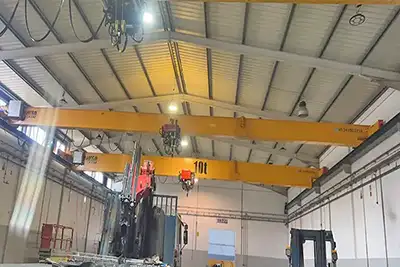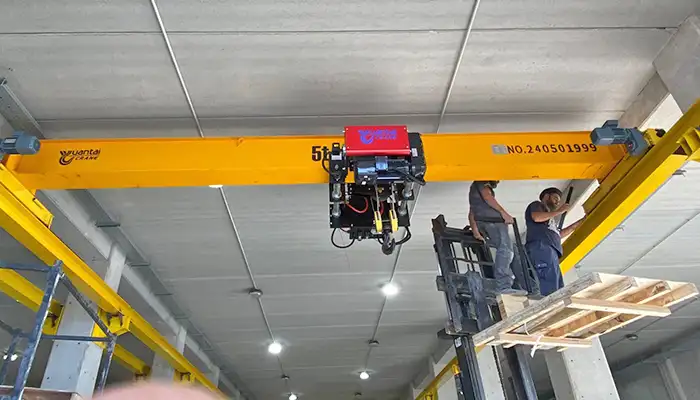Electric Hoist Gantry Crane in Prefabricated Construction 5 T 50 T
Electric Hoist Gantry Cranes 5 ton to 50 tons for handling Prefabricated building components, modular structures & construction materials at Prefabricated construction sites, building assembly yards。
Electric Hoist Gantry Cranes in Prefabricated Construction
In the realm of modern construction, efficiency and precision are paramount, leading to a surge in the use of prefabricated construction methods. One indispensable tool in this evolution is the Electric Hoist Gantry Crane. This blog aims to provide a comprehensive buying guide for those navigating the market in search of the ideal electric hoist gantry crane for prefabricated construction projects.
Electric hoist gantry cranes, often referred to as EHG cranes, are powerful lifting solutions designed for handling heavy loads with utmost precision. Their versatility stems from the combination of an electric hoist system and a gantry structure, enabling horizontal movement while efficiently lifting and lowering materials. These cranes find widespread applications across various industries, with a notable surge in demand within the prefabricated construction sector.
Prefabricated construction methods involve the assembly of building components off-site before transporting them to the construction site for final assembly. In this context, electric hoist gantry cranes play a pivotal role in the safe and efficient movement of prefabricated elements, ensuring a seamless integration process. The ability to lift and transport heavy components with precision significantly enhances the speed and accuracy of the construction process, making EHG cranes indispensable in modern construction practices.
Prefabricated Construction Needs
Prefabricated construction has emerged as a game-changer in the building industry, revolutionizing traditional construction methods. This method involves the manufacturing of building components in a controlled environment, away from the construction site, and transporting them for final assembly. The benefits are manifold: increased efficiency, reduced construction time, and improved quality control.
Specific Requirements for Electric Hoist Gantry Cranes in Prefabricated Construction
In the context of prefabricated construction, the role of electric hoist gantry cranes becomes pivotal. These cranes must be tailored to meet the specific demands of handling prefabricated components. Key considerations include the size, weight, and geometry of the prefabricated elements, as well as the need for precision during the assembly process. The crane should not only lift and transport materials efficiently but also ensure accurate placement during the assembly phase.
Efficiency in material handling becomes crucial when dealing with prefabricated components that may include large panels, modular sections, or even entire building modules. The electric hoist gantry crane must align with the intricacies of the prefabricated construction process, facilitating seamless movement and precise positioning of these components.
Weight Capacity and Size Considerations
One of the primary factors influencing the choice of an electric hoist gantry crane in prefabricated construction is its weight capacity. Understanding the weight of the heaviest prefabricated components is essential for selecting a crane that can handle the load safely. It's not just about the current project; forward-thinking involves considering potential future projects with different weight requirements.
Size considerations also play a vital role. The crane's span and height should accommodate the dimensions of the prefabricated components. Ensuring that the crane can cover the entire work area without obstruction is crucial for seamless operations. Additionally, the crane's footprint on the construction site needs careful evaluation to optimize space utilization.
Types of Electric Hoist Gantry Cranes
Navigating the world of electric hoist gantry cranes involves understanding the different types available, each designed to meet specific needs in prefabricated construction. Let's delve into the key differentiators that can significantly impact your choice.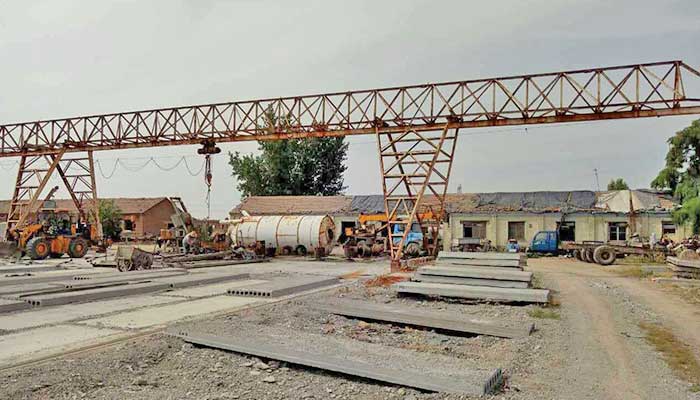
Single beam truss girder electric hoist gantry crane for prefabricated construction
Single Girder vs. Double Girder Cranes
Single Girder Cranes: These cranes feature a single horizontal beam for lifting and movement. They are more lightweight and cost-effective, making them suitable for smaller prefabricated components. Single girder cranes are known for their ease of installation and maintenance, making them a practical choice for certain prefabricated construction scenarios.
Double Girder Cranes: In contrast, double girder cranes boast two parallel beams, offering enhanced stability and higher lifting capacities. This type is ideal for handling heavier prefabricated elements and provides better control and precision during the material handling process. While they may have a higher upfront cost, their robust design and performance make them valuable assets for larger and more complex construction projects.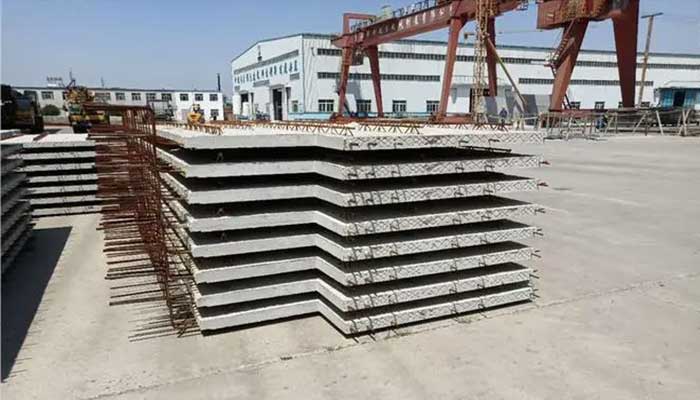
Double beam box girder electric hoist gantry crane for sale
Fixed vs. Adjustable Height Gantry Cranes
Fixed Height Gantry Cranes: As the name suggests, these cranes have a static height that cannot be adjusted. They are suitable for applications where the lifting requirements remain consistent, and the prefabricated components have standard dimensions. Fixed height gantry cranes offer simplicity and stability, often proving cost-effective for projects with consistent needs.
Adjustable Height Gantry Cranes: For versatility in handling prefabricated components of varying sizes, adjustable height gantry cranes are the preferred choice. These cranes allow you to modify the height based on the specific requirements of each project, providing adaptability to different scenarios. While they offer increased flexibility, it's essential to weigh the additional features against the associated costs.
Consideration of Mobility: Stationary vs. Portable Cranes
Stationary Gantry Cranes: Stationary cranes are firmly fixed in one location, offering stability and robustness. They are suitable for projects where the prefabricated components are consistently delivered to the same area. Stationary cranes are often more cost-effective and straightforward to install, making them a practical choice for specific prefabricated construction setups.
Portable Gantry Cranes: When the construction site demands mobility, portable gantry cranes come into play. These cranes feature wheels or casters, allowing them to be easily moved to different locations. Portable cranes are invaluable for projects with varying assembly points or when prefabricated components need to be transported within the construction site. However, their mobility often comes with a trade-off in terms of load capacity and stability.
Understanding the nuances of these crane types is crucial for aligning your choice with the specific needs of your prefabricated construction project. In the next section, we'll explore power sources and efficiency considerations to further refine your decision-making process. Stay tuned for insights into selecting the right power system for your electric hoist gantry crane.
Power Source and Efficiency
Efficiency in prefabricated construction relies heavily on the power source and performance of the electric hoist gantry crane. In this section, we will explore the critical considerations related to the power systems and overall efficiency of these cranes.
Electric vs. Hydraulic Hoist Systems
Electric Hoist Systems: Electric hoist systems are powered by electricity and are widely used for their precision, speed, and reliability. They offer smooth and controlled lifting and lowering of prefabricated components. Electric hoists are suitable for applications where consistent and precise movement is crucial, contributing to the overall efficiency of the construction process. Additionally, electric systems tend to require less maintenance compared to hydraulic counterparts.
Hydraulic Hoist Systems: Hydraulic hoist systems utilize hydraulic power to lift and lower loads. These systems are known for their strength and ability to handle heavy loads. While hydraulic systems are robust, they may have slightly less precise control compared to electric systems. Hydraulic hoists are often chosen for their raw power, making them suitable for lifting exceptionally heavy prefabricated elements.
Power Requirements and Energy Efficiency
The power requirements of your electric hoist gantry crane is essential for seamless integration into your prefabricated construction project. Consider the voltage, phase, and frequency requirements of the crane and ensure they align with the available power supply on your construction site. Additionally, assess the energy efficiency of the crane to minimize operational costs and environmental impact.
Modern electric hoist gantry cranes often come equipped with energy-efficient features such as regenerative braking systems and variable frequency drives. These technologies not only enhance the crane's performance but also contribute to energy savings during operation.
Adaptability to Various Power Sources
Construction sites may have diverse power sources, ranging from standard electrical outlets to generators or alternative energy systems. A versatile electric hoist gantry crane should be adaptable to various power sources commonly found on construction sites. This adaptability ensures that the crane remains operational under different circumstances, providing a reliable solution for a wide range of projects.
Safety Features
Safety is paramount in any construction environment, and electric hoist gantry cranes are no exception. In this section, we'll explore the crucial safety features that should be integral to your decision-making process when selecting a crane for prefabricated construction.
Overload Protection Systems
- Understanding Overload Protection:Overloading poses a significant risk to both the crane and the safety of the construction site. Overload protection systems are designed to prevent the crane from lifting loads beyond its specified capacity. This crucial feature ensures that the crane operates within safe limits, mitigating the risk of accidents due to excessive loads.
- Considerations for Prefabricated Construction:Given the varying weights and dimensions of prefabricated components, it's imperative to choose a crane equipped with a reliable overload protection system. The system should not only detect overloads promptly but also provide visual or audible warnings to alert operators. Investing in a crane with advanced overload protection technology contributes to a safer working environment and protects the longevity of the crane itself.
Emergency Stop Mechanisms
- Purpose and Implementation:Emergency stop mechanisms are fundamental safety features that enable immediate halting of crane operations in case of emergencies. These mechanisms are crucial for preventing accidents, injuries, or damage to materials during unforeseen circumstances.
- Integration in Prefabricated Construction:In prefabricated construction, where precision is paramount, emergency stop mechanisms play a pivotal role in averting potential disasters. Whether it's a sudden change in weather conditions or an unexpected obstacle in the crane's path, the ability to halt operations instantly ensures the safety of personnel and materials. Look for cranes with easily accessible and clearly labeled emergency stop buttons for quick response times.
Limit Switches and Collision Prevention Technology
- Limit Switches:Limit switches are safety devices that prevent the crane from over-traveling in specific directions. These switches define the permissible range of motion for the crane and its hoisting equipment, avoiding collisions with structures or other equipment.
- Collision Prevention Technology:Advanced electric hoist gantry cranes often come equipped with collision prevention technology. This may include sensors, cameras, or other detection mechanisms that identify potential collisions and automatically halt or adjust the crane's movements.
- Application in Prefabricated Construction:In prefabricated construction sites, where space can be limited and the movement of large components is intricate, limit switches and collision prevention technology are indispensable. These features not only protect the crane from damage but also safeguard workers and materials, ensuring a smooth and accident-free construction process.
As we move forward, we'll delve into the construction and durability aspects of electric hoist gantry cranes. Understanding the materials and construction methods ensures that the chosen crane can withstand the rigors of prefabricated construction environments. Stay tuned for insights into selecting a durable and reliable crane for your projects.
Durability and Construction
Ensuring the durability of an electric hoist gantry crane is pivotal for its long-term performance in the demanding environment of prefabricated construction. Let's explore the key considerations related to the materials used, corrosion resistance, and overall longevity of these essential construction tools.
Materials Used in Construction
- Structural Components:The materials used in the construction of the crane's structural components significantly impact its strength and durability. High-quality steel, especially in critical areas like girders and supporting structures, enhances the crane's ability to withstand heavy loads and constant use.
- Hoist Mechanism:The materials comprising the hoist mechanism, including the drum, gears, and cables, should also be robust and resistant to wear. Stainless steel or other corrosion-resistant materials are often employed in these components to ensure longevity and reliable performance.
Corrosion Resistance and Weatherproofing
- External Finishes:Given the diverse environmental conditions construction sites may encounter, corrosion resistance is a critical factor. Cranes with proper external finishes, such as protective coatings or galvanization, exhibit enhanced resistance to rust and corrosion. This feature is particularly crucial in areas with high humidity, salt exposure, or inclement weather.
- Weatherproofing Features:Weatherproofing extends beyond corrosion resistance and encompasses features that protect the crane's internal components from environmental elements. Sealed electrical components, weatherproof enclosures, and effective drainage systems contribute to the crane's resilience in adverse weather conditions.
Longevity and Maintenance Requirements
- Design for Longevity:The design of the electric hoist gantry crane should prioritize longevity, taking into account the expected frequency of use and the weight of the materials it will handle. Investing in a crane designed for durability ensures a more extended service life and minimizes the risk of unexpected breakdowns.
- Maintenance Requirements:Understanding the maintenance needs of the crane is crucial for its sustained performance. Choose a crane with accessible maintenance points, user-friendly inspection processes, and clear guidelines for routine checks. Regular and preventive maintenance not only extends the crane's life but also contributes to the overall safety of the construction site.
Control Mechanisms
The control mechanisms of an electric hoist gantry crane play a crucial role in its usability, efficiency, and safety. In this section, we'll explore the available control options, integration with automation systems, and the importance of user-friendly interfaces.
Manual vs. Remote Control Options
- Manual Control:Manual control options involve the direct operation of the crane by an operator using physical controls. While traditional, manual control remains a reliable option, especially for simpler tasks and scenarios where the operator has a clear line of sight to the load.
- Remote Control:Remote control options have become increasingly popular for their versatility and safety advantages. Remote-controlled cranes allow operators to manage the crane's movements from a safe distance. This is particularly valuable in prefabricated construction, where precise positioning of materials is crucial. Remote control enhances visibility, reduces the risk of accidents, and facilitates more efficient material handling.
Integration with Automation Systems
- Automation for Efficiency:The integration of electric hoist gantry cranes with automation systems is a significant advancement, contributing to enhanced efficiency in prefabricated construction. Automation allows for pre-programmed movements, precise positioning, and coordination with other machinery or assembly processes. Automated systems are particularly beneficial in large-scale projects where repetitive tasks can be streamlined for optimal time and resource utilization.
- Smart Systems for Safety:Modern cranes may incorporate smart systems that provide real-time data on crane performance, load monitoring, and potential issues. Integration with automation not only improves operational efficiency but also adds an extra layer of safety through continuous monitoring and data-driven decision-making.
User-Friendly Interface and Training Requirements
- Intuitive Interfaces:The user interface of the crane's control system should be intuitive and user-friendly. This is especially important for operators who may be required to quickly adapt to different tasks and scenarios. Clear and responsive interfaces contribute to smoother operations and reduce the likelihood of errors.
- Training for Efficient Operation:Regardless of the control mechanism chosen, providing comprehensive training for crane operators is essential. Training programs should cover not only the basic operation of the crane but also safety protocols, emergency procedures, and troubleshooting. Well-trained operators contribute to safer construction sites, optimized crane performance, and increased overall efficiency.
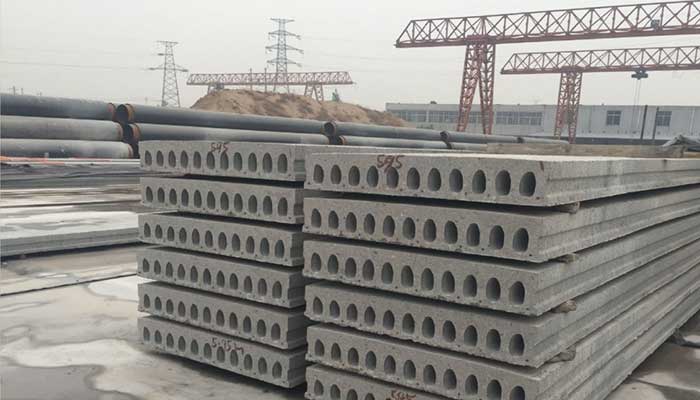
Budget Considerations
Making informed budgetary decisions is integral to the successful integration of an electric hoist gantry crane into your prefabricated construction project. In this section, we will explore the key financial aspects to consider when evaluating and planning for the acquisition of a crane.
Initial Purchase Cost
- Understanding Upfront Investment:The initial purchase cost is a critical factor in the decision-making process. Different types of electric hoist gantry cranes come with varying price points based on their specifications, lifting capacities, and features. Consider your project requirements, including the weight and size of prefabricated components, to determine the appropriate crane type and capacity. While it may be tempting to opt for the lowest upfront cost, it's essential to balance this with the crane's performance and suitability for your project's needs.
- Quality and Reliability:Investing in a high-quality crane may involve a higher initial cost but often pays off in terms of durability, performance, and long-term reliability. Consider the reputation of the manufacturer, the materials used in construction, and the technology incorporated into the crane when evaluating the initial purchase cost.
Installation and Setup Expenses
- Site-Specific Considerations:Installation and setup expenses can vary based on the specific requirements of your construction site. Factors such as the terrain, accessibility, and foundation requirements play a crucial role in determining these costs. Consider conducting a thorough site analysis to identify any potential challenges that may impact installation.
- Professional Installation vs. DIY:While some cranes may allow for user-friendly installation, complex or larger cranes often require professional installation services. Factor in the cost of hiring experienced technicians or engineers to ensure the crane is installed correctly and safely. Professional installation not only reduces the risk of errors but also contributes to the longevity and optimal performance of the crane.
Long-Term Maintenance and Operating Costs
- Predictive Maintenance:Long-term maintenance is a critical aspect of the total cost of ownership for an electric hoist gantry crane. Consider cranes with predictive maintenance features, such as advanced monitoring systems that provide real-time data on the crane's condition. Predictive maintenance helps identify potential issues before they escalate, reducing downtime and overall maintenance costs.
- Energy Efficiency and Operating Costs:Evaluate the energy efficiency of the crane to estimate its long-term operating costs. Cranes with energy-saving features, such as regenerative braking and variable frequency drives, can contribute to significant savings over the crane's lifespan. Consider the local energy rates and the expected frequency of crane use when assessing long-term operating costs.
By carefully considering these budgetary aspects, you can make informed decisions that align with both your financial constraints and the requirements of your prefabricated construction projects. In the final section of this buying guide, we'll delve into the importance of the manufacturer's reputation and support in ensuring a successful and reliable crane investment. Stay tuned for insights into researching and evaluating crane manufacturers for your construction needs.
Manufacturer Reputation and Support
The reputation and support provided by the manufacturer are critical considerations when selecting an electric hoist gantry crane. In this section, we'll explore the key factors to assess when researching manufacturers and ensuring ongoing support for your crane investment.
Researching and Evaluating Manufacturers
- Industry Experience and Expertise:Begin by researching the manufacturers in the electric hoist gantry crane market. Consider their industry experience and expertise in designing and producing cranes. Manufacturers with a long history and a proven track record are more likely to provide reliable and high-quality products.
- Product Range and Customization:Evaluate the manufacturer's product range and the extent to which they offer customization options. A manufacturer with a diverse range of crane models and the ability to tailor solutions to specific project needs demonstrates versatility and adaptability. Look for a manufacturer capable of meeting the unique requirements of prefabricated construction.
Warranty and After-Sales Support
- Comprehensive Warranty Coverage:Review the warranty offerings provided by the manufacturer. A comprehensive warranty is indicative of the manufacturer's confidence in the durability and performance of their cranes. Pay attention to the coverage duration and the specific components covered under the warranty.
- After-Sales Support Services:After-sales support is crucial for addressing any issues that may arise during the crane's lifespan. Assess the manufacturer's after-sales support services, including technical assistance, spare parts availability, and maintenance support. Manufacturers with a robust support infrastructure contribute to minimizing downtime and ensuring the continuous operation of the crane.
Customer Reviews and Testimonials
- Gathering Feedback:Customer reviews and testimonials offer valuable insights into the real-world performance of a manufacturer's electric hoist gantry cranes. Explore online platforms, industry forums, and testimonials on the manufacturer's website to gather feedback from actual users. Positive reviews and satisfied customers are indicative of a manufacturer's commitment to quality and customer satisfaction.
- Engaging with References:If possible, engage with references provided by the manufacturer. Reach out to other construction professionals or companies that have previously purchased cranes from the manufacturer. Direct communication with references can provide specific insights into the purchasing experience, crane performance, and the level of support received.
In the concluding section of this buying guide, we'll explore the importance of regulatory compliance when selecting an electric hoist gantry crane. Adherence to industry standards and local regulations ensures the safety and legality of your construction operations. Stay tuned for insights into navigating regulatory considerations for your crane investment.
Regulatory Compliance
Ensuring regulatory compliance is a fundamental aspect of selecting an electric hoist gantry crane for prefabricated construction. In this section, we'll explore the importance of adherence to industry standards, certification, and compliance with safety guidelines, as well as the consideration of local building codes and permitting requirements.
Adherence to Industry Standards and Regulations
Industry Standards:Before making a crane purchase, it's crucial to ensure that the manufacturer and the crane itself adhere to industry standards and regulations. Industry standards, such as those set by organizations like the Occupational Safety and Health Administration (OSHA) or the European Committee for Standardization (CEN), provide benchmarks for safety, design, and performance. Verify that the crane meets or exceeds these standards to ensure a safe and compliant operation.
Certification and Compliance with Safety Guidelines
- Seeking Certifications:Certifications from recognized bodies further validate the safety and quality of an electric hoist gantry crane. Look for cranes that carry certifications from reputable organizations, such as the International Organization for Standardization (ISO) or the Crane Manufacturers Association of America (CMAA). Certification ensures that the crane has undergone rigorous testing and meets established safety guidelines.
- Compliance with Safety Guidelines:Beyond certifications, the crane should comply with specific safety guidelines relevant to its operation. This includes features like emergency stop mechanisms, overload protection, and other safety protocols outlined in industry standards. A thorough review of the crane's safety features and design is essential for compliance with safety guidelines.
Local Building Codes and Permitting Requirements
- Local Regulations:Construction projects are subject to local building codes and regulations. Before installing an electric hoist gantry crane, familiarize yourself with the building codes and regulatory requirements specific to your location. Local authorities may have guidelines governing crane operation, structural requirements, and safety protocols that must be strictly adhered to.
- Securing Permits:In many jurisdictions, obtaining permits is a mandatory step before installing and operating a crane. Work with local authorities to secure the necessary permits, ensuring that your crane complies with all relevant regulations. Failure to obtain the required permits may result in legal consequences and disruptions to your construction project.
By prioritizing regulatory compliance, you not only ensure the safety of your construction site but also mitigate the risk of legal complications. In the final section of this buying guide, we'll recap key considerations and provide concluding recommendations for selecting the right electric hoist gantry crane for your prefabricated construction projects. Stay tuned for a summary of the essential factors to guide your decision-making process.
Custom Electric Hoist Gantry Cranes for Prefabricated Construction
As we conclude this comprehensive buying guide for electric hoist gantry cranes in prefabricated construction, let's recap the key considerations, offer final recommendations, and emphasize the importance of ongoing research and continuous improvement.
Throughout this guide, we've explored crucial factors to consider when choosing an electric hoist gantry crane for prefabricated construction:
- Understanding Prefabricated Construction Needs:Tailoring the crane to the specific requirements of prefabricated construction, considering weight capacity, and size considerations.
- Types of Electric Hoist Gantry Cranes:Choosing between single and double girder cranes, fixed and adjustable height options, and stationary versus portable configurations.
- Power Source and Efficiency:Evaluating electric versus hydraulic hoist systems, power requirements, energy efficiency, and adaptability to various power sources.
- Safety Features:Incorporating overload protection systems, emergency stop mechanisms, limit switches, and collision prevention technology for a secure construction environment.
- Durability and Construction:Assessing materials used, corrosion resistance, weatherproofing, and considering longevity and maintenance requirements for a durable crane.
- Control Mechanisms:Choosing between manual and remote control options, integrating with automation systems, and ensuring a user-friendly interface with effective training programs.
- Budget Considerations:Evaluating initial purchase costs, installation and setup expenses, and long-term maintenance and operating costs to align with financial constraints.
- Manufacturer Reputation and Support:Researching and evaluating manufacturers, considering warranty and after-sales support, and gathering customer reviews and testimonials for a reliable investment.
- Regulatory Compliance:Adhering to industry standards and regulations, seeking certifications, and complying with local building codes and permitting requirements to ensure legal and safe crane operations.
- Case Studies and Success Stories:Learning from real-world examples and best practices in implementing electric hoist gantry cranes in prefabricated construction projects.
Final Recommendations for Electric Hoist Gantry Crane Buyers in Prefabricated Construction
In making your final decisions, prioritize the following:
- Safety First:Opt for cranes with robust safety features to ensure the well-being of personnel and materials.
- Tailored Solutions:Choose a crane type and capacity that aligns with the specific needs of your prefabricated construction projects.
- Reputable Manufacturers:Select a crane from a manufacturer with a proven track record, comprehensive support services, and positive customer reviews.
- Compliance with Regulations:Ensure the chosen crane complies with industry standards, holds relevant certifications, and meets local regulatory requirements.
- Cost-Effective Efficiency:Balance initial costs with long-term efficiency and factor in considerations such as energy efficiency and maintenance requirements.
The construction industry evolves, and technology advances. Stay abreast of the latest developments in electric hoist gantry cranes, safety protocols, and construction methodologies. Continuous improvement in your understanding of the available technologies and best practices will contribute to the success of your prefabricated construction projects.
Embark on your journey with confidence, armed with the knowledge gained from this buying guide. May your selection of an electric hoist gantry crane lead to safe, efficient, and successful prefabricated construction endeavors.


